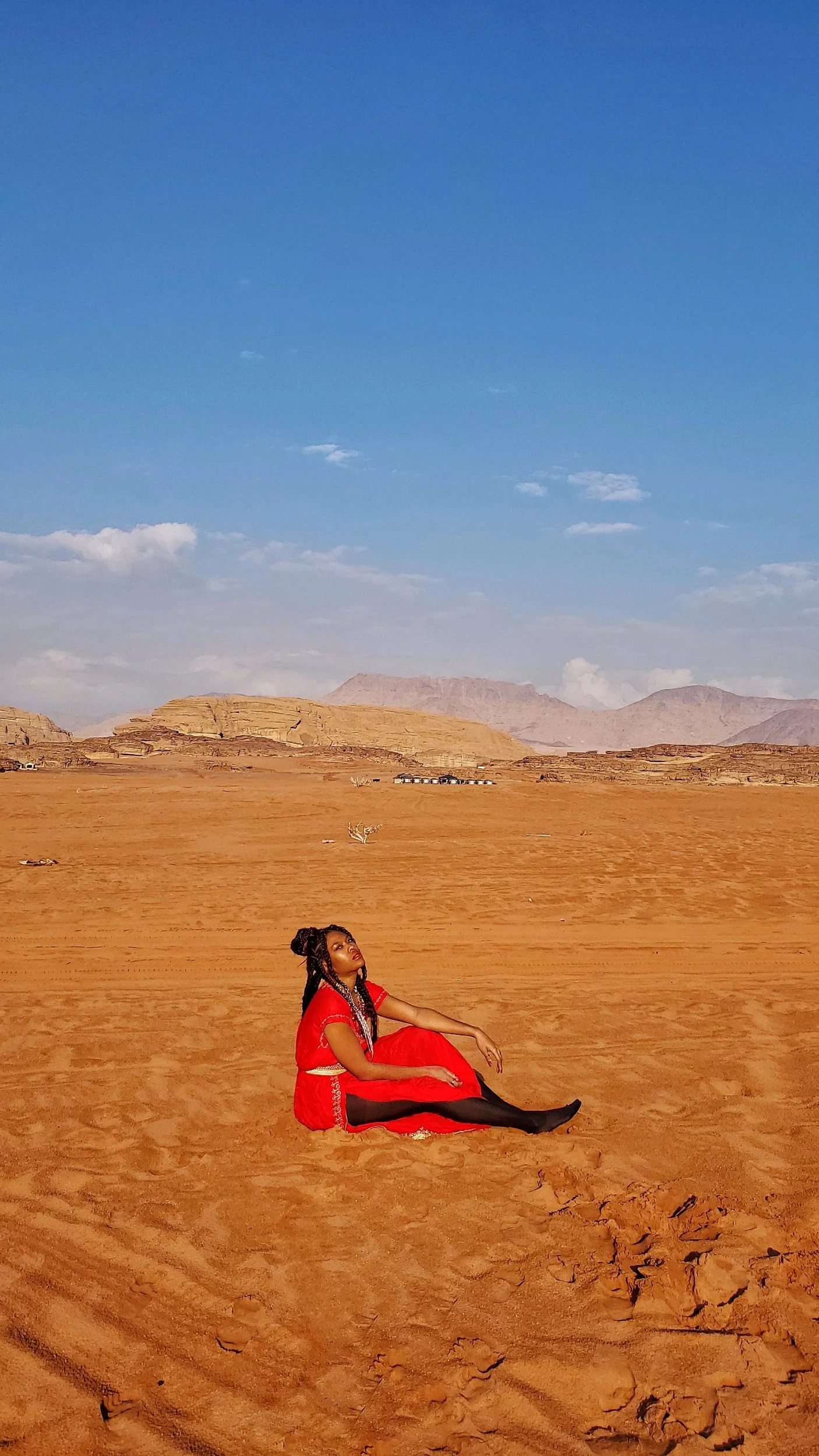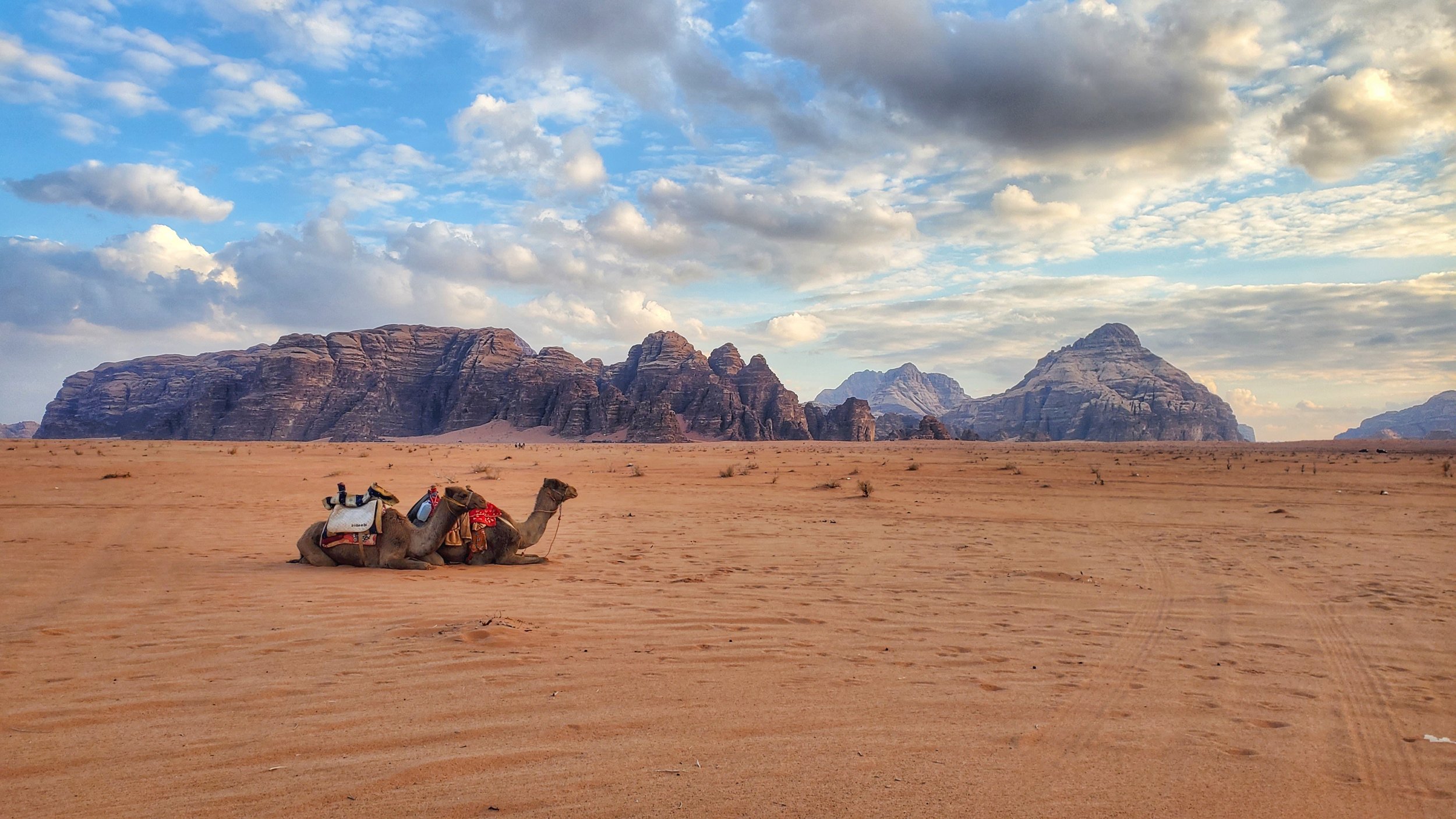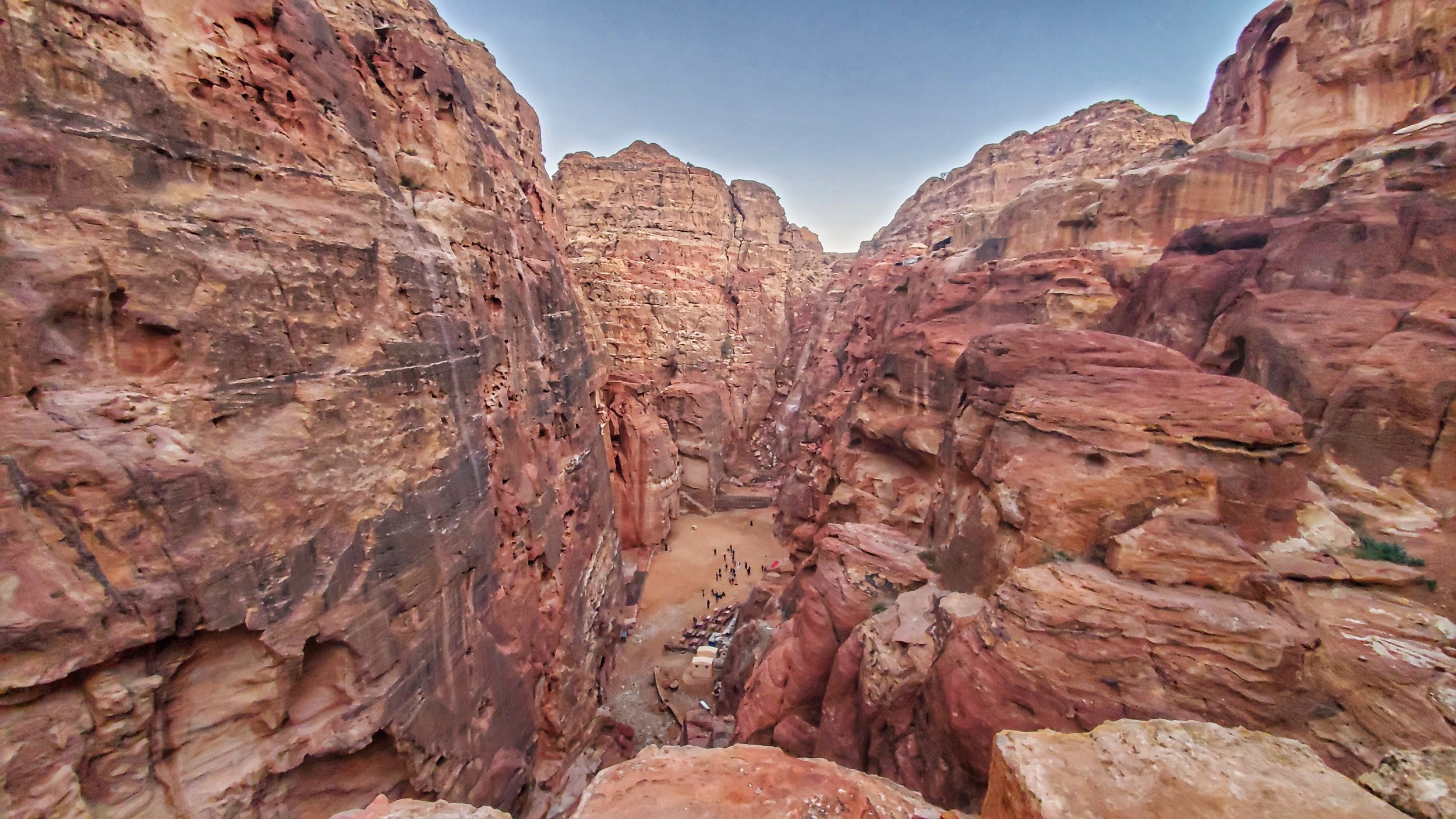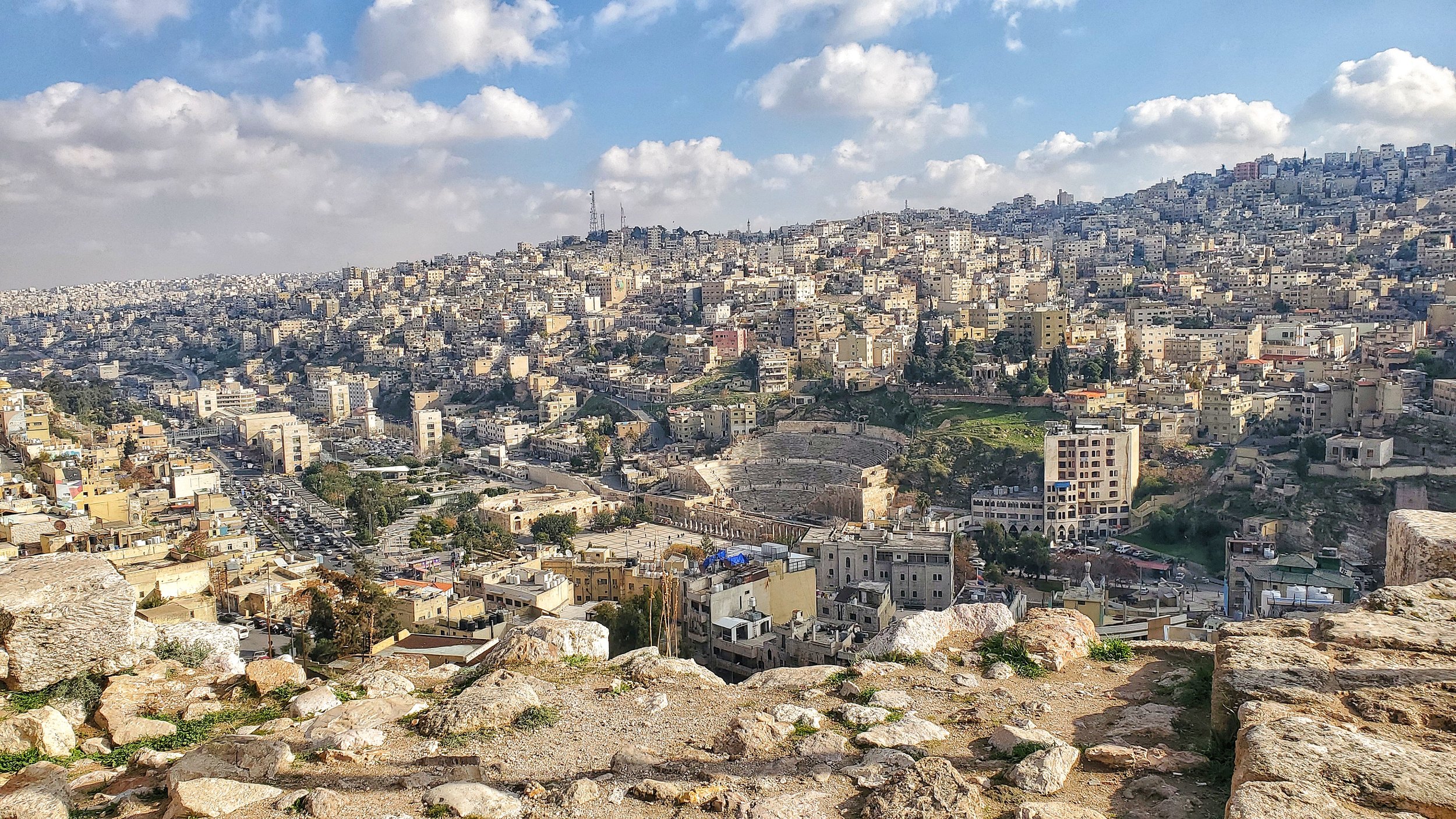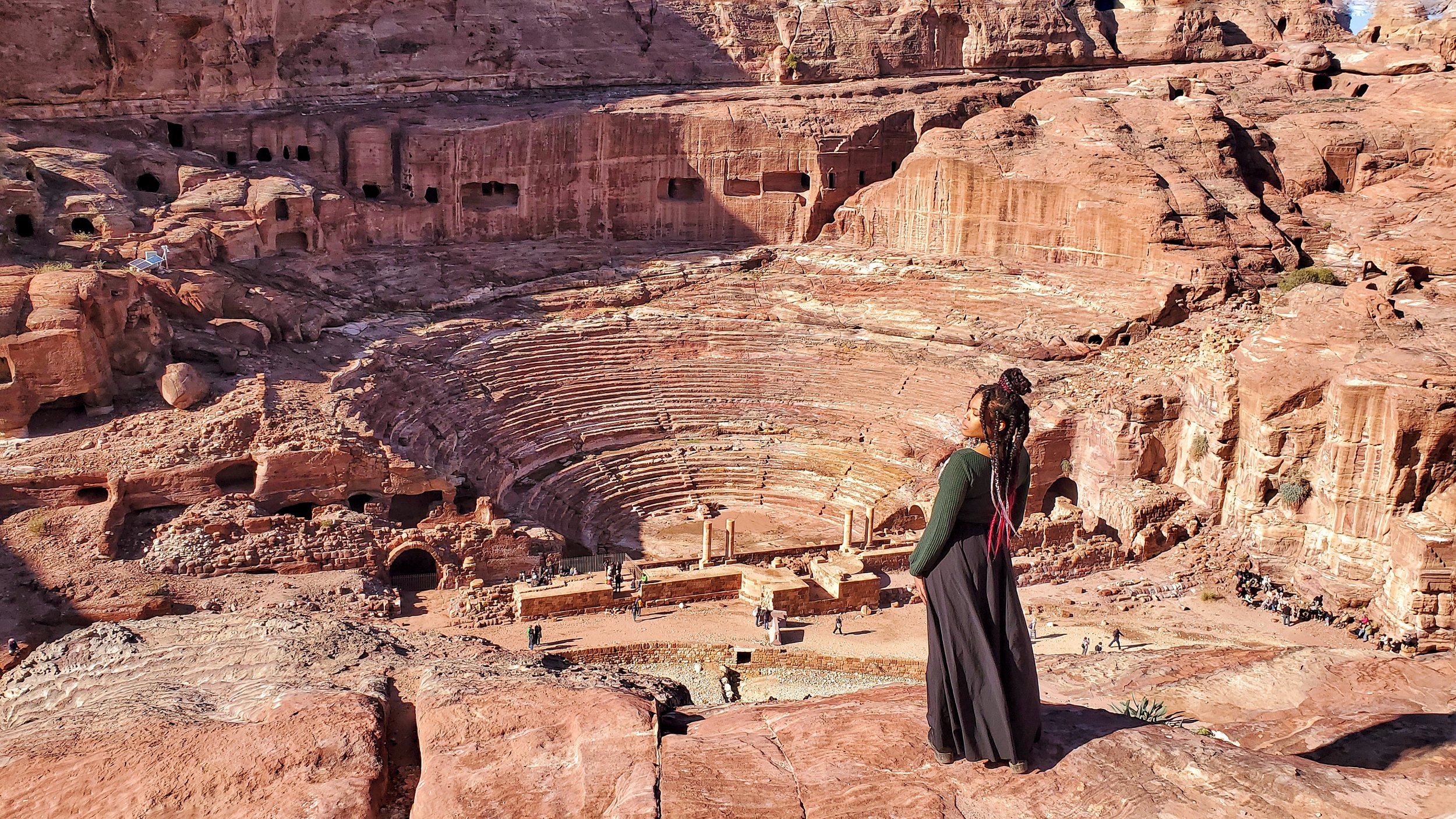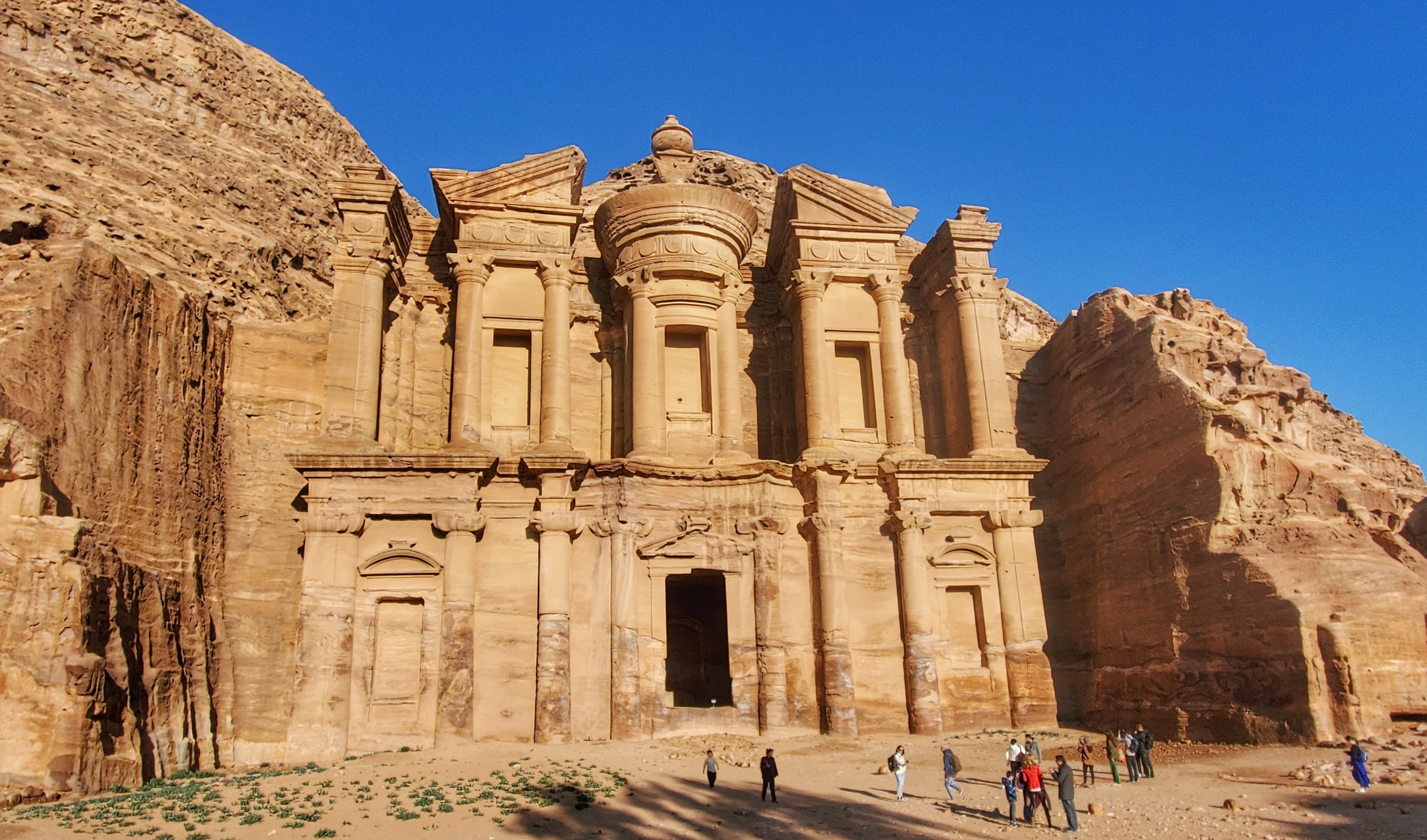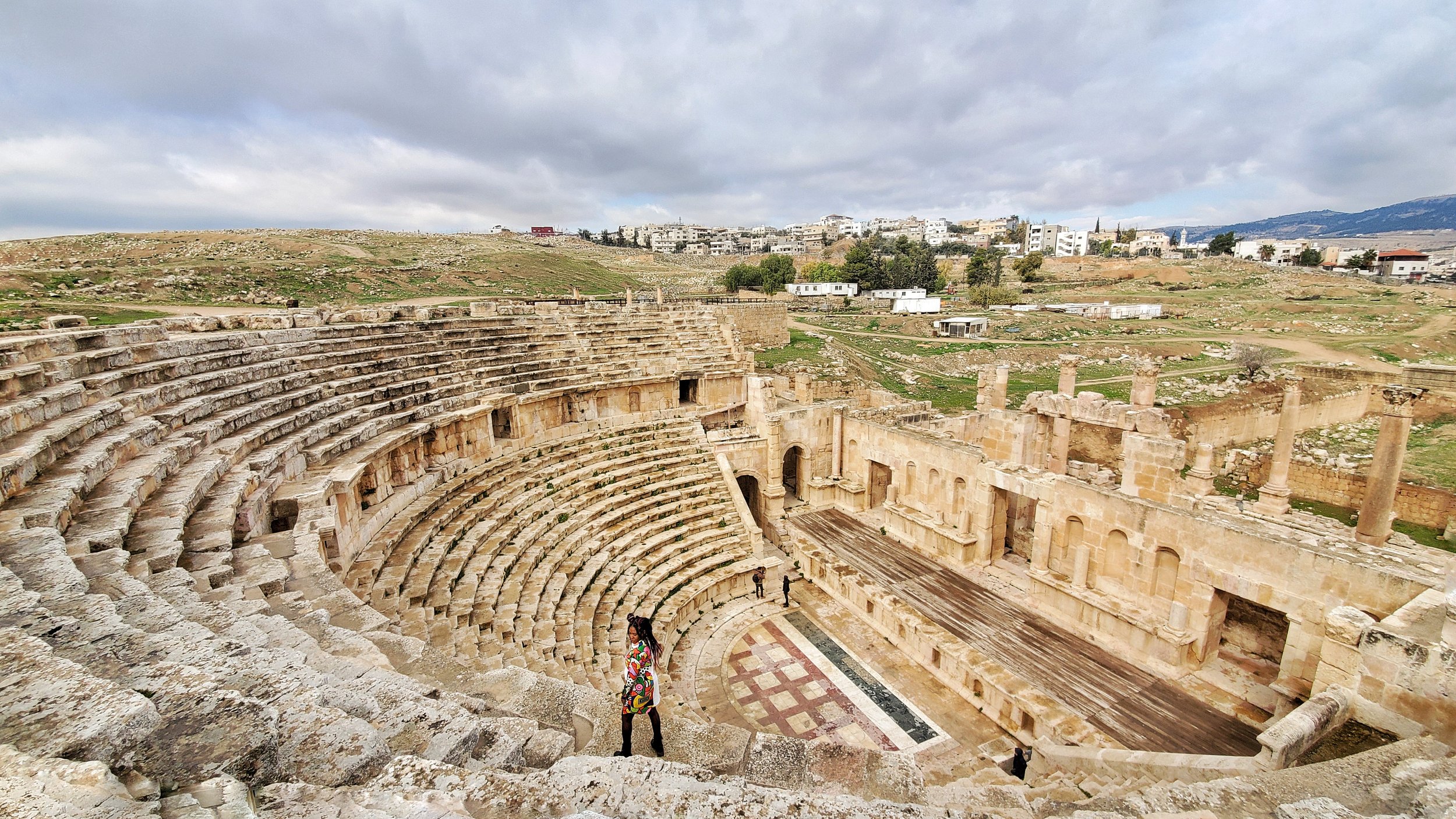Ahlan bik to Jordan, the Hashemite Kingdom, and one of the safest countries in the Middle East. Bordered by Lebanon, Syria, Israel, Iraq and Saudi Arabia, the nearly landlocked Muslim nation has many notable monuments to discover, including a Wonder of the Modern World. From the briny buoyancy of the Dead Sea to the extraterrestrial terrain of Wadi Rum, there is a bundle of beautiful places to ticket off your bucket list.
Planning a trip abroad soon? For the best places to visit in Jordan, consider yourself covered since this listicle will go through all the highlights as well as some hidden gems more off the beaten path. Whether you’re into hiking to the most scenic viewpoints, prefer scuba-diving to the greatest depths, or enjoy visiting ancient ruins, Jordan has something for everyone.
With so much to see in Jordan, it can actually be difficult to fit everything in so plan to spend at least a week exploring its rocky landscape at the apex of the Arabian Peninsula. You won’t regret it!
8 Best Places to Visit in Jordan
The Legend
Jordan’s story stretches back thousands of centuries to the Prehistoric Age when the first humans roamed the earth and, by the Stone Age, the region (known as Transjordan) was occupied by several biblical kingdoms as part of ancient Palestine. Due to Transjordan’s location at the intersection of Africa, Asia, and Europe, it had become a frequent crossroad for tradesmen, immigrants, and warring tribes well before the Iron Age. Among these were the Kingdoms of Ammon, Moab, and Edom, whose hold in the area would continue to dwindle over the eons as they were conquered by the Babylonians who were then replaced by the Persians and then the Hellenic Greeks, and finally the Romans in the 1st century BC.
Only the Nabataean Kingdom seemed to endure through the centuries, emerging as one of few that managed to retain some semblance of independence under Roman rule, thanks largely to their control of trade routes. With their immense wealth, their capital of Petra thrived, even after the kingdom was invaded by the Romans in the 2nd century AD. However, after the Roman Empire fractured in the 4th century AD, Christianity became the dominant religion under the reign of Byzantines until the new empire fell to Arabic Muslims in the 7th century.
In the 12th century AD, the Crusades came to Transjordan, incorporating the region of Transjordan into the Kingdom of Jerusalem, which led to the construction of many castles such as in Al-Karak. The Crusades were unsuccessful in the end, ultimately defeated by the Ayyubid Dynasty just decades later, only for their rivals to lose to the Mamluk Sultanate in the 13th century.
When the Ottomans came to power in the early 16th century, their arrival signaled the downfall of Transjordan as they neglected the local population, save for taxation purposes. Several Bedouin tribes began to move into the area along with other Muslim émigrés from neighboring nations, resulting in civil unrest as various factions attempted to jockey for control of the few resources. Exactly four centuries would go by under the stagnating rule of the Ottomans until the Arab Revolt during World War I, a period of conflict and bloodshed that would last for years all across the Ottoman Empire.
Long story short, amidst all the mayhem, the French and the British secretly began to divide the territory up for themselves, even outlining a section for Jewish resettlement. Eventually, the Emirate of Transjordan was established as a British protectorate until Jordan finally gained independence in 1946, becoming a member of the United Nations less than a decade later.
These days, Jordan stands as a modernized beacon among its peers for its progressive views and its generosity to its neighbors. Following the constant political and social upheaval in the region, it has opened its borders to refugees from Syria, Palestine, and many more nations, making it the second-largest refuge in the world with over 3 million displaced people. Also home to copious religious landmarks, the country has long had a reputation as a pilgrimage site, drawing in scores of visitors of all faiths from the farthest corners of the known world. With friendly locals, tasty cuisine, and breathtaking monuments, it’s easy to see why Jordan has earned its reputation as one of the best travel destinations in the Middle East.
8. Irbid
Quick Rundown:
The second-biggest city in Jordan by population and the third-largest by size, Irbid is located a mere 70 kilometers away from the capital of Amman and just 20 kilometers south of the Syrian border. Inhabited as early as the Bronze Age around five thousand years ago, the settlement was originally named Arabella before it was conquered by the Muslim Caliphate and renamed to Irbid (sometimes referred to as ‘‘The Bride of the North.’’). These days, Irbid is a sprawling metropolis and home to several prestigious universities, including the Jordan University of Science and Technology and Yarmouk University, which have earned it the title of the country’s Arab Capital of Culture in 2022.
Why You Should Visit:
Thanks to the many higher-learning institutions proliferating throughout the city, Irbid has a youthful college-town vibe as most services cater to students, both domestic and foreign. The trend is even more reflected in the nightlife which tends to be more progressive and stay open late, particularly along University Street, which has the most internet cafes in the world, according to the Guinness Book of World Records.
Moreover, Irbid has two of Jordan’s most prominent museums, the Jordan Natural History Museum and the Museums of Jordanian Heritage, both housed on Yarmouk University’s campus. Additionally, it’s a popular shopping hub due to the numerous shopping centers and open-air markets dominating the city center, making it an ideal place to hunt for souvenirs.
Situated in northern Jordan, Irbid is also the perfect gateway to explore the Byzantine, Hellenic, and Roman ruins scattered across the area. At the crux between Amman and Syria, the city is also a popular hotspot for daredevils looking to cross into the war-torn nation. If you’re looking to visit Syria as well, Irbid is the best destination to start.
7. Jordan River
Quick rundown:
Stretching over 350 kilometers between the borders of Jordan, the West Bank, Syria, and Israel, the Jordan River is a famous waterway of biblical proportions. The nation of Jordan owes its name to this historic body of water as does the West Bank. Fed by tributaries from Mount Hermon in Lebonan and Syria, the Jordan River continues onto the Sea of Galilee in northern Israel, with the river’s path then flowing along the West Bank down to the Dead Sea, effectively dividing the region between Palestine and Isreal to the west and Jordan and Syria to the east.
Why You Should Visit:
Over the centuries, the Jordan River has been a major pilgrimage site, attracting visitors of all walks of faith since ancient times as a horizon to be crossed. As attested to by several religious texts, the Jordan River has been the location of copious biblical events, ingraining its waters with heavy symbolism of spiritual renewal and absolution.
In the Old Testament, the Jordan River marked the boundary of the Promised Land that God gifted the Israelites after 40 years of wandering around in the desert. In its sequel, the New Testament, John the Baptist baptized the son of God, helping him be born anew. It should be no surprise then that the Jordan River is also a major source of Holy Water, having been sanctified by the body of Christ.
Whether or not you’re a devout follower, the Jordan River is a sacred place to visit, despite the growing conflict between its surrounding nations and them all laying claim to its possession. Only a tenth of its biblical size due to modern interference in the form of dams and other manmade obstructions, make sure to visit the Jordan River before it dries up.
6. Jerash
Quick rundown:
Situated less than 50 kilometers north of the capital of Amman, Jerash is a city lost in time, with some of the best ruins in Jordan. It was built upon the site of an ancient settlement whose origins stretch back all the way to the Neolithic Era over nine thousand years ago. The community continued to thrive during the Hellenistic, Roman, and Byzantine Empires, especially as a crucial nexus between Damascus (Syria) and Petra as well as between Tyre (Lebanon) and Joppa (modern-day Jaffa in Israel).
However, the ancient city would meet its downfall in the 7th century AD after it was completely looted by the Persians, only to be conquered by the Muslims of the Umayyad Caliphate a few years later. Many affluent citizens would migrate to Damascus, the Umayyad seat of power, taking their wealth with them, and many more would follow when the Umayyad¡s successor, the Abbasid Caliphate, further removed the capital to Baghdad (Afghanistan) in the 8th century. More misfortune befell the region as several earthquakes rocked the few inhabitants that remained, causing them to flee the once-great city. By the 19th century, the city would be in ruins, completely abandoned.
Why you should visit:
Affectionately nicknamed ‘‘the Pompeii of the Middle East,’’ Jerash is one of the best-preserved Greo-Roman archeological sites since the ruins lay undisturbed for centers. The site was fortunately rediscovered in the early 20th century, leading to massive evacuation projections that saw a large demographic resurgence in the area. Centered around the tourism industry, the revived economy has increasingly grown as the current city continues to spread around the unburied ruins, making Jerash the second-most visited landmark in the country.
It’s not hard to see why, given the immaculate state of much of the ruins, including the impressive Arch of Hadrian, the stunning colonnaded street, the grand oval plaza as well as two amphitheaters. Wander around the vast ruins as you make your way to the Temples of Artemis or Zeus before spotting by Jerash Visitors Center to see some even more unearthed relics and gems.
5. Aqaba
Quick Rundown:
The only coastal city in Jordan, Aqaba is the most populated city on the gulf of the same name and the largest in southern Jordan. The first settlements have been dated back to the Copper Age about six thousand years ago when copper production and trade took off in the area. Referred to as Elath in the Hebrew Bible and as Aela in Latin, the ancient city’s strategic position at the crux between Asia and Africa made it a prosperous port.
As time went on, the maritime economy continued to prosper throughout the Hellenistic Era and even after the territory was annexed by the Romans in the 1st century BC. The seaside city greatly benefited as the endpoint of the Via Taiana Nova (AKA Trajan’s New Road), an ancient road laid by the Romans which connected from southern Syria all the way to the Red Sea. The area fell under Muslim rule by the 7th century AD and the original settlement was abandoned for a new Arabic city, Ayla, which would flourish despite exchanging hands between the Ummayid, Abbasid, and Famid Caliphates for centuries.
As part of the Crusades, the King of Jerusalem, Baldwin I, would invade the city in the 12th century and established a fortress as a military stronghold, only for it to be retaken a few decades later by the Ayyubid Dynasty. Aqaba would gain its current name by the late Middle Ages and the old fortress would be rebuilt by the last of the Mamluk Sultanate in the 16th century. However, when control fell to the Ottomans in the 16th century, the once-bustling trade center shrunk into a sleepy fishing village for the next four hundred years, a shadow of its former self.
Why You Should Visit:
Known as the Jewel of the Red Sea, Aqaba is the best place in Jordan to go snorkeling or scuba-diving thanks to the large amount tour operators distributed throughout the city. The seafloor in the Gulf of Aqaba is decorated with coral reefs abounding with aquatic life as well as sunken military vehicles which promote the growth of marine ecosystems while being stunning to look at.
Besides bridging the nations of Jordan, Egypt, and Israel along its coast, the Red Sea is also the site of Moses’ biblical miracle that led the Israelites out of Egypt and four hundred years of bondage. Even the Prophet Muhammad, the founder of Islam, is said to have reached Aqaba to extort tribute from the inhabitants on his expedition to conquer the Arabic Peninsula.
Aqaba also has many other claims to fame, such as Aqaba Church, the world’s oldest, purpose-built Christian church, erected in the late 3rd century by the Romans. Its predecessor, Ayla, was mentioned at various times in Arabian Nights (a prolific collection of Arabic folktales of Islam’s Golden Age and the inspiration for Disney’s Aladdin). The Battle of Aqaba in 1917 also made Lawrence of Arabia stand out as a notable historical figure, spawning an award-winning historical drama in the 1960s. In 2004, the world’s tallest flagpole (now the 6th-tallest) was erected to commemorate this battle, its staggering height rendering it visible from Egypt, Israel, and Saudi Arabia. If you enjoy a small-town vibe while having access to watersports, there’s literally no better place in Jordan than Aqaba.
4. Amman
Quick Rundown:
The capital of Jordan and the largest city by far, Amman is also the fifth-biggest city in the Arab world and one of the top ten in the Middle East. The sprawling metropolis is also the nation’s financial, political, and cultural center, housing over a third of Jordan’s population. The first evidence of life in the region traces back to the Neolithic Era and, by the 13th century BC, Rabat Amman would become the capital of the Ammonite Kingdom. Its strategic location along the King’s Highway (an ancient trade route that branched between Egypt, Syria, Anatolia, and Mesopotamia) made the settlement a vital presence in the area.
To make an extremely long story short, Amman would flourish under Hellenistic rule, changing its name to Philadephia after the Macedonian pharaoh of Egypt. Then came four years of Roman rule that saw the inauguration of its most noteworthy landmarks. However, when the Roman Empire fell, the Byzantines took over, only to cede to subsequent Muslim Caliphates who renamed the city, Amman. Due to mismanagement and several earthquakes, Amman’s former relevance would flounder, only to be bought by a Mamluk Emir in the 14th century AD. More mismanagement ensued, causing most inhabitants to flee and eventually the city would sit mostly abandoned for the next several centuries.
Repopulation would only commence around 1878, as thousands of Circassian Muslims fled the genocide brought on by the end of the 101-year Russian-Circassian War. Amman would later be the site of two important battles of World War I in 1918, as the inhabitants joined the fight to bring down their Ottoman rulers. This alliance would earn the entire region the status of a British protectorate state as the Emirate of Tranjordan in 1921, with Amman as its capital. Jordan would gain its independence from the British by 1946 and would gain its official title, Hashemite Kingdom of Jordan, in 1950, reopening its doors to copious generations of refugees from all across the conflict-ridden Arab world.
Why You Should Visit:
As the capital of the country, Amman has everything you could ever want, from bustling markets to late-night venues. Considered one of the most progressive cities in the Arab world, it’s one of the few places in Jordan you can find goods at reasonable prices if you know where to look in the bazaars near the Jordan Museum.
Amman is also home to many prominent monuments and cultural heritage sites along with ancient ruins. The Citadel of Amman, perched on the top of the city’s central hill, is considered one of the oldest continuously inhabited places in the world (besides the period between the 15th-19th centuries when it was mostly used as a refuge by nomadic Arab bedouins). The Citadel features ruins left by the Roman, Byzantine, and Umayyad occupations, and among these are the Temple of Hercules and the Umayyad Palace, and a mosque.
Visible from atop the Citadel, you should be able to spot Hashemite Plaza down below, bordered by the Roman Theatre, built to seat up to six thousand spectators, and the Odeon, a much smaller, 500-seat Roman theatre. Within walking distance, you can also stumble upon the Nymphaeum, a former public fountain, and the Grand Husseini Mosque, the largest mosque in Jordan.
For travelers in search of some nightlife, head either to Downtown Jordan to find the best food establishments or to Rainbow Street, a colorful promenade that holds the best bars, shisha lounges, and cafes. Named for the Rainbow Theatre on the same street, Rainbow Street shouldn’t be missed if you want to keep the partying going until late and there are plenty of places to choose from. Whether you’re attracted to Amman for its historical sites or party scene, you’re sure to be entertained.
3. Dead Sea
Quick Rundown:
The Dead Sea is as legendary as it is deadly, with the first references to the giant salt lake appearing in historic texts since Ancient Antiquity. Spanning 50 kilometers long and 15 kilometers at its widest, the Dead Sea is fed by the Jordan River which ends its 350-plus-kilometer run by emptying into the Jordan Rift Valley between Israel and Jordan.
Although called a sea due to popular nomenclature and its immense size (600 sq. kilometers), the Dead Sea is actually a landlocked lake that just also happens to be at the lowest point on Earth. With its surface lying around 420 meters below sea level, the depression has made the perfect receptacle for eons of salty run-off as freshwater from the Jordan River dissolves the minerals in the rocky terrain. Without a single outlet, the Dead Sea has only grown saltier with every passing century as its waters evaporate and become more concentrated, at nearly 30 percent.
At 304 meters deep and around eight times saltier than any ocean, the Dead Sea is also the deepest hypersaline lake in the world, meaning you’d have a lot of difficulties trying to dive to those depths as a result of its buoyant nature. Not that you’d really want to since the infamous lake has earned its name with good reason…
Why You Should Visit:
Apart from being the lowest point on Earth, the Dead Sea’s other claim to fame is in its name. Given how salty its waters are, the immense lake is far too noxious to sustain any marine life outside of a few microbes. Any fish that is unfortunate to be swept into the lake by the flow of the Jordan River is subject to a quick yet tortuous death, meaning the Dead Sea’s one of the safest places to swim as long as you don’t get any water in your eyes, ears, mouth, and nose (you’re just asking for a bad time if you do).
In fact, you can expect to see plenty of postage advising you not to accidentally expose any orifice to the briny waters unless you would like to suffer your own dismal fate. Its deceptively placid appearance aside, it’s true when they say that it’s nearly impossible to drown in the Dead Sea (as long as you float on your back). You won’t swim as much as you’ll bob along in the water but there’s no feeling more surreal than weightlessly drifting like a leaf on a pond.
What’s more, the deadly waters have some of the most therapeutic effects; their mineral-rich content has been reported to help alleviate pain from conditions such as arthritis and also to help treat skin diseases such as acne. Its highly sought-after mud is also sold the world over for its (ironically) hydrating benefits so why not cut out the middle man and fetch your own for an unbeatable souvenir?
2. Petra
Quick Rundown:
Petra has gone by many names since its inception; it was first known as Raqmu, a large metropolis and the capital city of the Nabataens who inhabited the area as early as the 4th century BC. These nomadic Arabs would thrive in the shadow of Jabal Al-Madbah Mountain in southwestern Jordan, establishing several successful settlements along trade routes that stretched from the Euphrates to the Red Sea. This prosperity led to the construction of Hellenistic rock-cut monuments carved right into the deep pinkish stone of the Arabah Valley, earning the capital its nickname, the Rose City.
Once home to as many as 30,000 residents at its peak, the Nabataen Kingdom would lose its independence at the turn of the 2nd century AD when it was annexed by the Roman Empire and renamed Arabia Petraea. What followed would be centuries of decline as its maritime trade routes became more popular, pulling influence away from the landlocked region. However, the final nail would be a disastrous earthquake in 363 AD, which destroyed copious structures and hobbled the water management system, causing many inhabitants to flee, never to return.
By the 7th century AD, Petra would be largely abandoned, save for the occasional Bedouin tribe roaming by. It would briefly be rediscovered in the 12th century by the Crusaders yet would remain lost for the next several centuries, ultimately uncovered by a Swiss geographer in 1812. After almost seven hundred years of neglectful obscurity, the Lost City would once again be found, quickly becoming Jordan’s most visited site.
Why You Should Visit:
What is there to say about these iconic ruins that hasn't already been said? Gaining UNESCO World Heritage Site status in 1985, Petra has also been hailed as one of the Seven Wonders of the New World, a must-see while in Jordan as a symbol of the developing nation. Moreover, the ancient city has plenty of biblical ties, purportedly being formed when Moses struck his staff upon the rock to conjure water for the ever-wandering Israelites (hence, why the current town is named Wadi Musa, after ‘‘the Valley of Moses’’). His brother, the Prophet Aaron, is also buried nearby at Mount Hor, commonly referred to as Mount Aaron.
After passing through the Siq (a narrow passage leading to Petra’s main entrance), you’ll arrive directly at the area’s most famous monument, Al-Khazneh (AKA the Treasury). Albeit, the site is also home to many noteworthy landmarks such as an amphitheater, royal tombs, and Ad Deir (AKA the Monastery). If you’re feeling adventurous enough, you can additionally make your way up to the High Place of Sacrifice, perched on the top of Jebel Madbah Mountain. It takes just about 800 steps to get to the top but the trek is worth it to see the view of the mountain valley from above. Just make sure to wear comfy shoes and bring plenty of water!
1. Wadi Rum
Quick Rundown:
My favorite place in Jordan, and the absolute highlight of my recent trip, was Wadi Rum, located in southern Jordan. This 720-square-kilometer expanse of protected desert reserve is around 60 kilometers east of Aqaba and is composed of several stunning natural formations such as sandstone mountains and desert oases. Also known as the Valley of the Moon, Wadi Rum is the largest valley in Jordan and the ideal destination for adventure travelers looking to explore some out-of-this-world terrain.
Bordered by granite rock and sandstone which have lent Wadi Rum’s landscape a reddish hue, you’ll feel as though you’ve been transported to Mars on Earth as you look out across its vast sand dunes. The area is also home to Jabal Umm ad Dami, the highest mountain in the country, from whose summit you can spot the Red Sea and the Saudi border on a clear day.
The otherworldly backdrop is so enchanting that T.E. Lawrence (AKA Lawrence of Arabia) once called it ‘‘vast, echoing and God-like’’ and used it as the inspiration to pen his autobiography about his time spent there during WWI. His novel would eventually be adapted into an epic Hollywood historical war drama but it wasn’t the only blockbuster to be filmed in Wadi Rum. Several other cinema darlings have used the crimson desert for their setting such as The Martian, Prometheus, Transformers: Revenge of the Fallen, Rogue One: A Star Wars Story, Star Wars: Rise of Skywalker, and Aladdin (2019), so you know there has to be something special about the place that photos just can’t do justice.
Why You Should Visit:
Besides being utterly gorgeous to stare at, Wadi Rum also has copious thrills to offer visitors. From camel rides across the desert at sunset to camping under the star-studded skies, you’ll have plenty of activities to keep you busy in this Arabian desert. If you find camels far too humpy, you can opt to go horseback riding atop the Arabian variety or even for a guided, open-air 4x4 jeep tour to all the vermillion desert’s most famous sites.
Some of the best natural landmarks include Burdah Rock Bridge, Red Sand Dune, Mushroom Rock, Um Frouth Rock Bridge, the Seven Pillars of Wisdom, Khazali Canyon, Siq Nuqra, Al Hasany Dunes, and Jebel Rum. There’s also Lawrence’s House, the remnants of the famed British soldier’s original dwelling, and Lawrence’s Spring, one of his preferred watering holes. For history buffs, make sure to also stop by the Anfashieh Inscriptions, prehistoric carvings left throughout Wadi Rum’s extensive network of caves and chasms.
Really want to get your blood pumping? Why not go hiking around Wadi Rum’s enormous rock formations and climb up some exceptional natural arches if you dare? Visiting a few of the sites can be a little tasking but certainly worth the effort for adventurous travelers who aren’t afraid to take a little risk for some stellar views. Better yet, how about scaling your way up using any of the rock-climbing routes pioneered by ancient Bedouins centuries ago?
Afterward, you can even stay overnight in a tent in a Bedouin-style camp or, for glampers, sleep in a Martian bubble dome. In warmer months, travelers can also choose to camp outside and slumber under the star-studded night sky. Whether or not, you consider yourself a daredevil in the making, Wadi Rum is sure to hold a bit of magic for everyone.
Final Thoughts
Jordan is one of the best countries to travel to at the moment for a plethora of factors. Due to the initial slow growth of its tourism sector, many of its main attractions are still quite untouched compared to other popular destinations around the globe. It’s also incredibly safe with some genuinely nice locals.
Furthermore, the Middle Eastern nation offers travelers a range of activities to keep them enthralled, from ancient ruins for cultural mavens to outdoor adventure opportunities for thrill-seekers. The local cuisine is also incredibly delectable and sure to please avid foodies while bargain-hunters will delight in all its charming markets where haggling is not only expected but encouraged.
While certain activities, such as transportation between places, can be quite pricy compared to its neighbors, you don’t necessarily have to break the bank to make the most of your time in the small nation. Online prices are sure to be much higher than just negotiating once on the ground so it’s best to ask around before committing cash to anything. Still, any money you spend is sure to culminate in the trip of a lifetime that you’ll never forget. Write me when you get there!
May you get lost in the wonder,
M

